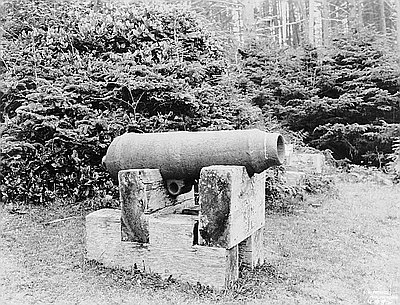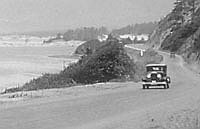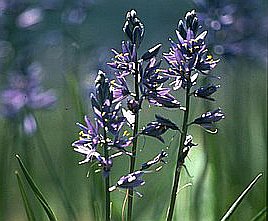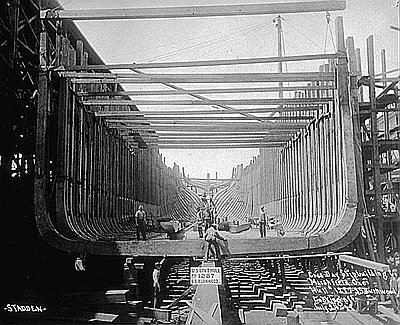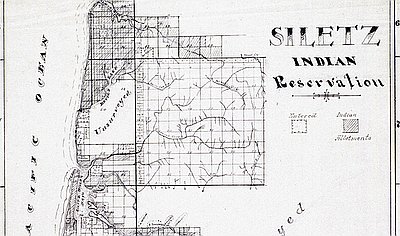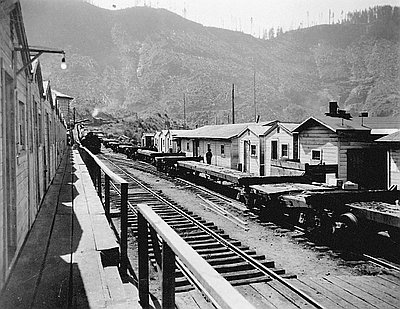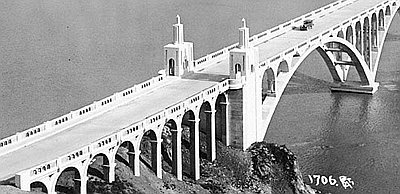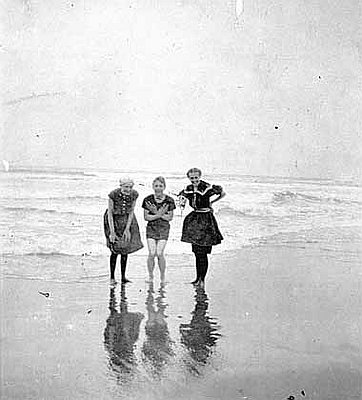Railroads and Highways
By the turn of the twentieth century, railroads had begun to penetrate the isolated communities on the coast. Until then, rivers, lakes, sloughs, and the beach were the primary transportation corridors, and the ocean was the gateway to the larger world. Because of early commerce with ports on the Pacific Rim, coastal residents often felt more connected with San Francisco and the Hawai‘ian Islands than they did with Portland and Eugene. By the 1860s, travelers could sail comfortably from Coos Bay to San Francisco in four or five days. When steamships arrived about 1880, they could make the trip in two or three days.
Overland travel, however, was difficult. A trip from Coos Bay to Roseburg, now eighty-five miles away by highway, consisted of a bumpy three-day horse or wagon ride over the Coos Bay Wagon Road, which opened in 1873. The road started at Isthmus Slough and snaked up the east fork of the Coquille to Sitkum, then down to Lookingglass and Tenmile on the Roseburg side. Travelers had to feed their horses along the way and sleep in or under their wagons. When stagecoach service began in 1893, travelers could ride in somewhat better style.
Because of that isolation, coastal residents had a sense of proud self-sufficiency. When the Southern Pacific Railroad announced in 1906 that it was planning a rail line from Eugene to Coos Bay, not everyone on Coos Bay favored the idea. One newspaper called the Southern Pacific “that ruthless invader of paradise,” and another writer argued that the Coos area had done just fine for itself and did not need a railroad. Construction was delayed until 1911, but the line finally arrived in Coos County in 1916. In addition to opening the Coos Bay area to the Willamette Valley and other points inland, the railroad created a camp for railroad construction workers at Reedsport, which became a permanent town in 1912.
Most people on Coos Bay looked forward to the railroad reaching the coast, including most residents of Tillamook Bay. “Tillamook is to be waked up this season,” the Yamhill Reporter announced in 1883. “The puff of the steam engine and the swirl of the circular saw will be echoed through its stillness before many weeks as a lumberman is putting up a mill of immense capacity where one of the rivers enters the bay….The erection of this first mill is a beginning of which the end cannot be seen. It is within reasonable probability that railroad communication will be established between Portland and Tillamook bay in a few years.”
In fact, it took a little longer. The Pacific Railway and Navigation Company started a rail line from the east side of the Coast Range in 1905 and finished it in 1911. The railroad was nicknamed “Punk, Rotten, and Nasty,” because the steep grades, hairpin curves, breathtaking trestles, and smoke from the firebox made passengers queasy. Still, with the coming of the railway, the Oregon Coast was linked more closely to the interior.
The beach was the closest thing residents had to an all-weather, all-season road, but the rocky headlands jutting into the Pacific made it impossible to travel very far that way. Some of the smaller headlands were passable at low tide, like Hug Point, north of Arch Cape on the northern coast. Hug Point got its name from travelers who had to hug the rocky hillside to get around it. According to a local history of Arch Cape, “foot and hand holes carved at the south side…permitted travelers to reach a ledge that followed a level fracture line between layers of sandstone. When the road was blasted out about 1908, that ledge disappeared, but the holes getting to it are still there and the fault line where the ledge used to be is still visible.”
Where the beach trails ended, wagon roads offered transportation over the high country. The first wagon road over Tillamook Head was a toll road. Its proprietor, H.F.L. Logan, charged ten cents for sheep and hogs, twenty-five cents for a “single horse, mule or ass,” and a dollar for a four-horse team. Because Tillamook Head is steep and crisscrossed with streams, the road was necessarily tortuous. David and Alma English describe how drivers coped in Arch Cape Chronicles:“The narrow road provided few turnouts so the driver stopped approximately every hundred feet. He bellowed loudly and if no answer came, forged ahead. At the end of the journey, the driver and his wagon waited until the tide was just right before crossing near the mouth of Elk Creek [present-day Ecola Creek on the south side of Tillamook Head], for those passengers wanting to reach Cannon Beach. The crossing was dangerous because the tides and river flow at times caused deeper water and different channels than expected.”
In 1899, Clatsop County’s beaches between high- and low-tide lines were designated public highways by the Oregon legislature. In 1913, at the behest of Governor Oswald West, this public right of way was extended to the California state line, a demonstration of the governor’s Progressive belief in the right of the public to regulate private property.
That same year, the legislature created the Oregon Highway Commission, which appointed a highway engineer whose task it was to complete the map of the state’s main roads. The following year, these roads—about 2,800 miles of them, only twenty-five of which were paved—were designated as Oregon’s state highway system.
In 1917, the legislature authorized a $6 million bond for highway construction and gave the Highway Commission this instruction: “Lift Oregon out of the mud.” Revenues from motor vehicle licenses would pay for road construction and maintenance. Two years later, Oregon became the first state to tax gasoline, with those revenues also dedicated to road building.
In the early 1920s, Oregon began building a highway between Astoria and the California state line. Initially conceived as a way to increase the state’s military preparedness, the road was named the Theodore Roosevelt Coast Military Highway. It was later renamed the Oregon Coast Highway; officially it is U.S. Highway 101. Construction began in 1920 and was finished in 1936. The 350-mile-long, breathtakingly scenic highway parallels the Pacific coastline for most of its length.
© Gail Wells, 2006. Updated and revised by OHP staff, 2014.
Sections
Related Historical Records
From Neakahnie Mountain near Manzanita
This panoramic view looks south along the Oregon coastline from the steep slopes of Neahkahnie Mountain. It was photographed by Wesley Andrews, a producer of scenic view postcards, …
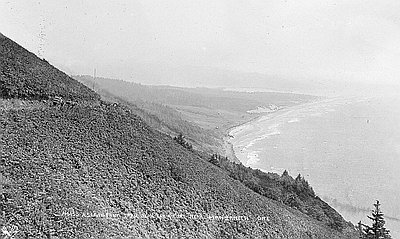
Railroad Station at Airlie, 1909
The photograph above shows the railroad station of the Southern Pacific Company and a warehouse at the small Willamette Valley town of Airlie in 1909. Airlie is a …
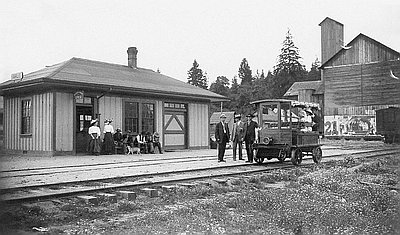
Cannon Beach Cannon
This photograph, taken by Arthur M. Prentiss, depicts the cannon that gave Cannon Beach its name. The cannon’s history includes a period as a U.S. Navy weapon, a …
